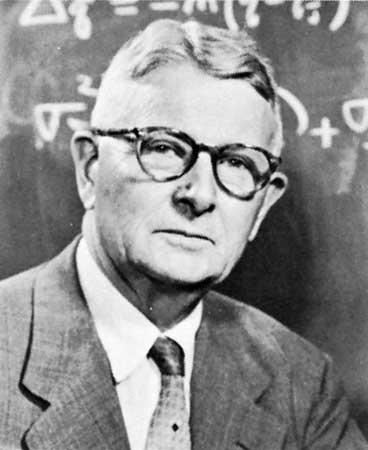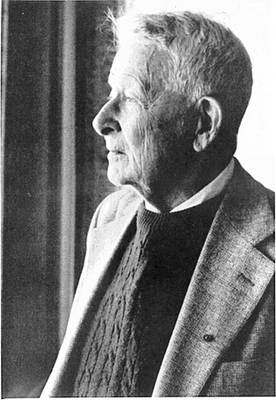<Back to Index>
- Geneticist Sewall Green Wright, 1889
- Poet Thomas Bracken, 1843
- 9th President of Austria and 4th Secretary General of the United Nations Kurt Josef Waldheim, 1918
PAGE SPONSOR



Sewall Green Wright (December 21, 1889 – March 3, 1988) was an American geneticist known for his influential work on evolutionary theory and also for his work on path analysis. With R.A. Fisher and J.B.S. Haldane, he was a founder of theoretical population genetics. He is the discoverer of the inbreeding coefficient and of methods of computing it in pedigrees. He extended this work to populations, computing the amount of inbreeding of members of populations as a result of random genetic drift, and he and Fisher pioneered methods for computing the distribution of gene frequencies among populations as a result of the interaction of natural selection, mutation, migration and genetic drift. The work of Fisher, Wright, and Haldane on theoretical population genetics was a major step in the development of the modern evolutionary synthesis of genetics with evolution. Wright also made major contributions to mammalian genetics and biochemical genetics.
Sewall Wright was born in Melrose, Massachusetts, to Philip Green Wright and Elizabeth Quincy Sewall Wright. His parents were first cousins, an interesting fact in light of Wright's later research on inbreeding. The family moved three years later after Philip accepted a teaching job at Lombard College, a Universalist college in Galesburg, Illinois. As a child, Wright helped his father and brother print and publish an early book of poems by his father's student Carl Sandburg.
He was the oldest of three gifted brothers — the others being the aeronautical engineer Theodore Paul Wright and the political scientist Quincy Wright. From an early age Wright had a love and talent for mathematics and biology. Wright attended Galesburg High School and graduated in 1906. He then enrolled in Lombard College where his father taught, to study mathematics. He was influenced greatly by Professor Wilhelmine Entemann Key, one of the first women to receive a Ph.D. in biology. Wright received his Ph.D. from Harvard University, where he worked at the Bussey Institute with the pioneering mammalian geneticist William Ernest Castle investigating the inheritance of coat colors in mammals. He worked for the U.S. Department of Agriculture until 1925, when he joined the Department of Zoology at the University of Chicago. He remained there until his retirement in 1955, when he moved to the University of Wisconsin – Madison. He received many honors in his long career, including the National Medal of Science (1966), the Balzan Prize (1984), and the Darwin Medal of the Royal Society (1980). He was a member of the National Academy of Sciences and a Foreign Member of the Royal Society. For his work on genetics of evolutionary processes, Wright was awarded the Daniel Giraud Elliot Medal from the National Academy of Sciences in 1945.
Wright married Louise Lane Williams (1895 – 1975) in 1921. They had three children: Richard, Robert, and Elizabeth. His papers on inbreeding, mating systems, and genetic drift make him a principal founder of theoretical population genetics, along with R.A. Fisher and J.B.S. Haldane. Their theoretical work is the origin of the modern evolutionary synthesis or neodarwinian synthesis. Wright was the inventor / discoverer of the inbreeding coefficient and F-statistics, standard tools in population genetics. He was the chief developer of the mathematical theory of genetic drift, which is sometimes known as the Sewall Wright effect, cumulative stochastic changes in gene frequencies that
arise from random births, deaths, and Mendelian segregations in
reproduction. In this work he also introduced the concept of effective population size. Wright was convinced that the interaction of genetic drift and
the other evolutionary forces was important in the process of
adaptation. He described the relationship between genotype or phenotype
and fitness as fitness surfaces or
fitness landscapes. On these landscapes mean population fitness was the height, plotted against horizontal axes representing the allele frequencies or the average phenotypes of the population. Natural selection would lead to a population climbing the nearest peak, while genetic drift would cause random wandering. Wright's explanation for stasis was that organisms come to occupy adaptive peaks.
In order to evolve to another, higher peak, the species would first
have to pass through a valley of maladaptive intermediate stages. This
could happen by genetic drift if
the population is small enough. If a species was divided into small
populations, some could find higher peaks. If there was some gene flow between the populations, these adaptations could spread to the rest of the species. This was Wright's shifting balance theory of evolution. There has been much skepticism among evolutionary biologists
as to whether these rather delicate conditions hold often in natural
populations. Wright had a long standing and bitter debate about this
with R.A. Fisher, who felt that most populations in nature were too large for these effects of genetic drift to be important. Wright strongly influenced Jay Lush, who was the most influential figure in introducing quantitative genetics into animal and plant breeding. Wright's statistical method of path analysis, which he invented in 1921 and which was one of the first methods using a graphical model,
is still widely used in social science. He was a hugely influential
reviewer of manuscripts, as one of the most frequent reviewers for
Genetics. Such was his reputation that he was often credited with
reviews that he did not write. From
1915 to 1925 Wright was employed by the Animal Husbandry Division of
the U.S. Bureau of Animal Husbandry. His main project was to
investigate the inbreeding that had occurred in the artificial
selection that resulted in the leading breeds of livestock used in
American beef production. He also performed experiments with 80,000
guinea pigs in the study of physiological genetics. Furthermore he
analyzed characters of some 40,000 guinea pigs in 23 strains of
brother - sister matings against a random bred stock.
The concentrated study of these two groups of mammals eventually led to
the Shifting Balance Theory and the concept of "surfaces of selective
value" in 1932. He did major work on the genetics of guinea pigs,
and many of his students became influential in the development of
mammalian genetics. He appreciated as early as 1917 that genes acted by
controlling enzymes. An
anecdote about Wright, disclaimed by Wright himself, describes a
lecture during which Wright tucked an unruly guinea pig under his
armpit, where he usually held a chalkboard eraser: according to the
anecdote, at the conclusion of the lecture, Wright absent-mindedly
began to erase the blackboard using the guinea pig.
Wright was one of the few geneticists of his time to venture into philosophy. He found a union of concept in Charles Hartshorne,
who became a lifelong friend and philosophical collaborator. Wright
believed that the birth of the consciousness was not due to a
mysterious property of increasing complexity, but rather an inherent
property, therefore implying these properties were in the most
elementary particles.
Wright and Fisher, along with J.B.S. Haldane, were the key figures in the modern synthesis that brought genetics and evolution together. Their work was essential to the contributions of Dobzhansky, Mayr, Simpson, Julian Huxley, and Stebbins. The modern synthesis was the most important development in evolutionary biology after Darwin. Wright also had a major effect on the development of mammalian genetics and biochemical genetics.